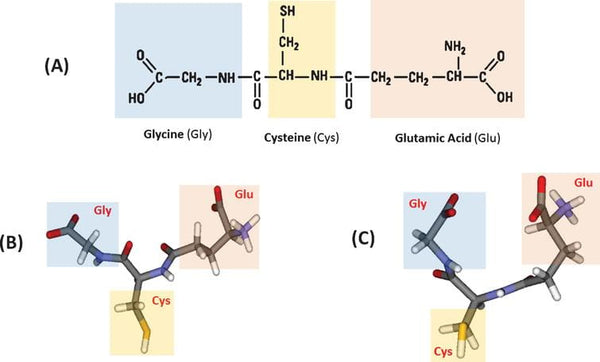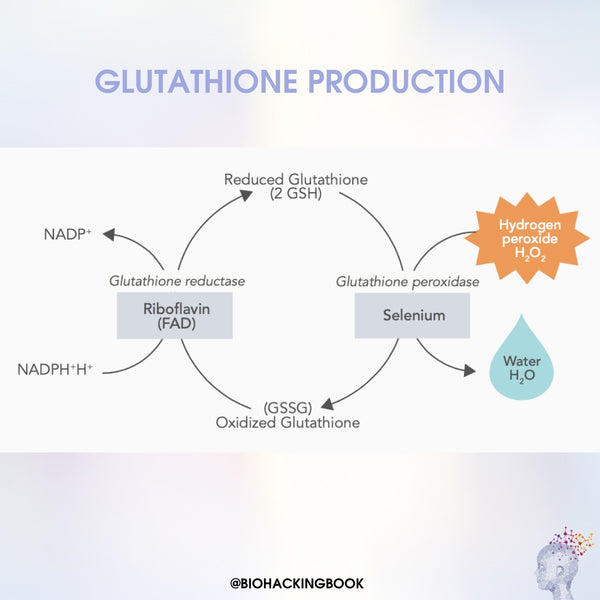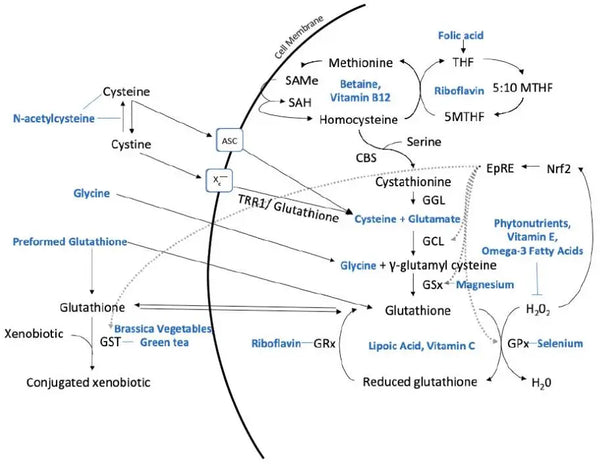Glutathione (the Master Antioxidant)
Glutathione (GSH) is a large tripeptide composed of three independent amino acids (glutamic acid, cysteine, and glycine). It acts as an critical antioxidant in many organisms such as plants, fungi, protozoa, bacteria, and humans. The structure of glutathione allows it to act as both an oxidant (GHS) and a reducing agent (GSSG), thus regulating the optimal amount of oxidative stress in the body. However, glutathione levels may be depleted or significantly reduced if the body's oxidative stress is very high and plasma antioxidant capacity is clearly reduced.

Image: Glutathione and its structural conformations. (A) Molecular structure of glutathione, (B) the extended, and (C) the folded conformations.
Source: Mandal, P. & Shukla, D. & Govind, V. & Boulard, Y. & Ersland, L. (2017). Glutathione conformations and its implications for in vivo magnetic resonance spectroscopy. Journal of Alzheimer's Disease 59 (2): 537–541.
Glutathione synthesis
The body synthesizes glutathione from amino acids such as cysteine, glutamic acid, and glycine. Decreased dietary intake of these can lead to deficient glutathione formation. The role of cysteine in this synthesis is critical, i.e. it acts chemically as a limiting factor in the synthesis of glutathione if cysteine is not obtained from enough food.
The most important role of glutathione in the body is the glutathione peroxidase-catalyzed reaction in the mitochondria of cells. There, hydrogen peroxide and lipid peroxides are reduced by glutathione to oxidized glutathione disulfide. This is converted back to glutathione by the enzyme glutathione disulfide reductase by the molecule NADPH, i.e. the reaction consumes energy. The relationship between glutathione (GSH) and glutathione disulfide (GSSG) reflects the intracellular oxidation-reduction potential.

Other important roles of glutathione in the body include:
- Regulates nitric oxide production and recycling
- Used in DNA synthesis and repair processes
- Used in protein synthesis, amino acid transport, and activation of many enzymes
- Needed for iron metabolism
- Needed for controlled and programmed cell death (apoptosis) and in the normal cell growth process
- Removal and elimination of heavy metals
- Elimination of cancer cells
- Regulate immune function and T cells activation
The following factors contribute to lowered glutathione levels:
- Chronic stress
- Injuries and traumas
- Oxidative stress and free oxygen radicals
- Accumulation of toxins in the body
- Pollution
- Poor nutrition and nutrient intake
- Radiation
- Aging
- Infections
- Excessive alcohol consumption
- Smoking
- Genetic defects
Glutathione dysregulation may increase the risk of the following diseases and conditions:
- Diabetes
- Pulmonary fibrosis
- Liver fibrosis
- Alcoholic liver disease
- Endotoxemia
- Cholestatic liver damage
Summary of nutrients and foods to support optimal glutathione levels:
- Alpha lipoic-acid: 300 mg 3× day; 200–600 mg/day
- Brassica vegetables: 250 g/day
- Curcumin: Doses up to 12 g/day safe; 1–2 g/day found to benefit antioxidant capacity; increased bioavailability with piperine
- Fruit and vegetable juices: 300–400 mL/day
- Glutathione (Liposomal): 500–1000 mg/day
- Glycine: 100 mg/kg/day
- Green tea: 4 cups/day
- N-acetylcysteine: 600–1200 mg/day in divided doses, but up to 6000 mg/day have been shown effective in studies
- Omega-3 fatty acids: 4000 mg/day
- Salmon: 150 g twice a week
- Selenium: 247 μg/day of selenium enriched yeast; 100–200 ug/day
- Vitamin C: 500–2000 mg/day
- Vitamin E: 100–400 IU/day
- Whey Protein: 40 g/day
This is a list from the 2019 study summarizing all glutathione-boosting nutrients. However, it is not meaningful or even wise to use all these compounds at the same time. First and foremost investing in whole foods and phytonutrients is the best approach and supplementation is used when needed to support the glutathione production.
Numerous other nutritional factors such as selenium, thiamine, riboflavin, as well as pyridoxine, cobalamin, folate, and minerals such as magnesium and zinc, aid in the methylation process, also contribute to the synthesis of glutathione.

Image: Hepatic synthesis of glutathione and nutritional substrates, co-factors, and other nutrients that influence metabolism.
Source: Minich, D. & Brown, B. (2019). A Review of Dietary (Phyto)Nutrients for Glutathione Support. Nutrients 11 (9): 2073.
Glutathione can also be taken as a dietary supplement. However, based on previous studies, its absorption is not very efficient and no oxidative stress-reducing effects have been observed unless glutathione is “packaged” into liposomal form (liposomes). A randomized study published in 2015 showed for the first time that oral reduced glutathione (GSH) supplementation is effective in raising intracellular glutathione levels (250-1000 mg/day).
Still, liposomal glutathione increases cellular glutathione levels even more effectively. However, further research on glutathione supplements is still needed to confirm the potential beneficial effects of oral glutathione in the body.
///





